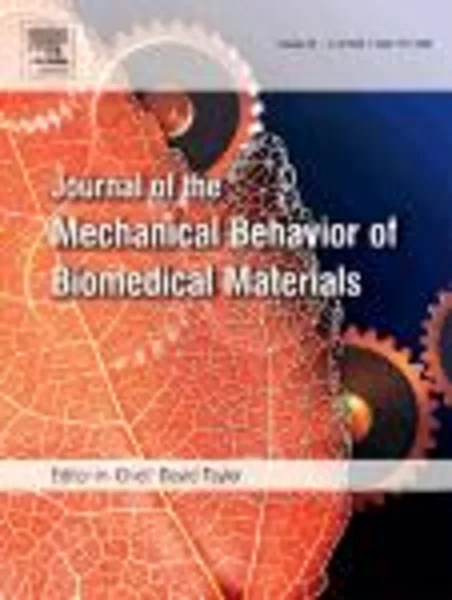-
the effect of friction on indenter force and pile-up in numerical simulations of bone nanoindentation
جزئیات بیشتر مقاله- تاریخ ارائه: 1394/01/01
- تاریخ انتشار در تی پی بین: 1394/01/01
- تعداد بازدید: 745
- تعداد پرسش و پاسخ ها: 0
- شماره تماس دبیرخانه رویداد: -
nanoindentation is a useful technique for probing the mechanical properties of bone, and finite element (fe) modeling of the indentation allows inverse determination of elastoplastic constitutive properties. however, all but one fe study to date have assumed frictionless contact between indenter and bone. the aim of this study was to explore the effect of friction in simulations of bone nanoindentation. two-dimensional axisymmetric fe simulations were performed using a spheroconical indenter of tip radius 0.6 μm and angle 90°. the coefficient of friction between indenter and bone was varied between 0.0 (frictionless) and 0.3. isotropic linear elasticity was used in all simulations, with bone elastic modulus e=13.56 gpa and poisson’s ratio of 0.3. plasticity was incorporated using both drucker–prager and von mises yield surfaces. friction had a modest effect on the predicted force–indentation curve for both von mises and drucker–prager plasticity, reducing maximum indenter displacement by 10% and 20% respectively as friction coefficient was increased from zero to 0.3 (at a maximum indenter force of 5 mn). however, friction has a much greater effect on predicted pile-up after indentation, reducing predicted pile-up from 0.27 to 0.11 μm with a von mises model, and from 0.09 to 0.02 μm with drucker–prager plasticity. we conclude that it is potentially important to include friction in nanoindentation simulations of bone if pile-up is used to compare simulation results with experiment.
مقالات جدیدترین رویدادها
-
استفاده از تحلیل اهمیت-عملکرد در ارائه الگوی مدیریت خلاقیت سازمانی و ارائه راهکار جهت بهبود
-
بررسی تاثیر ارزش وجوه نقد مازاد بر ساختار سرمایه شرکت های پذیرفته شده در بورس اوراق بهادار تهران
-
بررسی تأثیر سطح افشای ریسک بر قرارداد بدهی شرکت های پذیرفته شده در بورس اوراق بهادار تهران
-
بررسی تأثیر رتبه بندی اعتباری مبتنی بر مدل امتیاز بازار نوظهور بر نقد شوندگی سهام با تأکید بر خصوصی سازی شرکت ها
-
تأثیر آمیخته بازاریابی پوشاک ایرانی بر تصویر ذهنی مشتری پوشاک ایرانی (هاکوپیان)
-
مقایسه اثر فلوکونازول و گریزئوفولوین بر کچلی سر
-
بررسی آزمایشگاهی رشد حباب محلول غیر الکترولیت آب و اتانول در جوشش استخری روی استوانه استیل افقی
-
رتبه بندی واحدهای پالایشگاه گاز جهت بازیابی گرمایی به روش تحلیل سلسه مراتبی
-
بررسی نقش نیتریک اکساید در گشادی عروق کرونر حاصل از عصاره پاغازه (falcaria vulgaris) در قلب مجزای موش صحرایی
-
electrohydrodynamic dispersion of deformable aerosols in the presence of an electric field and chemical reaction using taylor dispersion model
مقالات جدیدترین ژورنال ها
-
مدیریت و بررسی افسردگی دانش آموزان دختر مقطع متوسطه دوم در دروان کرونا در شهرستان دزفول
-
مدیریت و بررسی خرد سیاسی در اندیشه ی فردوسی در ادب ایران
-
واکاوی و مدیریت توصیفی قلمدان(جاکلیدی)ضریح در موزه آستان قدس رضوی
-
بررسی تاثیر خلاقیت، دانش و انگیزه کارکنان بر پیشنهادات نوآورانه کارکنان ( مورد مطالعه: هتل های 3 و 4 ستاره استان کرمان)
-
بررسی تاثیر کیفیت سیستم های اطلاعاتی بر تصمیم گیری موفق در شرکتهای تولیدی استان اصفهان (مورد مطالعه: مدیران شرکتهای تولیدی استان اصفهان)
-
اثربخشی آموزش راهبردهای حافظه فعال بر انگیزش تحصیلی و اضطراب امتحان دانش آموزان
-
شناسایی و اولویت بندی انواع ریسک در پروژه های روستایی و پاسخ به آنها
-
بررسی علل تخریب محیط زیست در گذار به اقتصاد سبز
-
an investigation into risk factors for knee arthroplasty as a knee osteoarthritis (oa) treatment
-
flexural performance of composite ultra-high-performance concrete-encased steel hollow beams




سوال خود را در مورد این مقاله مطرح نمایید :